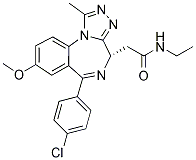All AbMole products are for research use only, cannot be used for human consumption.

I-BET-762 (GSK525762) is a small molecule inhibitor of the BET (Bromodomain and Extra-Terminal) family of bromodomain-containing proteins. BET inhibitor I-BET-762 binds to the acetylated lysine recognition motifs on the bromodomain of BET proteins, thereby preventing the interaction between the BET proteins and acetylated histone peptides. I-BET-762 (GSK525762) was previously shown to suppress the production of proinflammatory proteins by macrophages and block acute inflammation in mice. Treatment of naive CD4(+) T cells with I-BET-762 during the first 2 d of differentiation had long-lasting effects on subsequent gene expression and cytokine production. The short 2-d treatment with I-BET-762 inhibited the ability of antigen-specific T cells, differentiated under Th1 but not Th17 conditions in vitro, to induce pathogenesis in an adoptive transfer model of experimental autoimmune encephalomyelitis. The suppressive effects of I-BET-762 on T-cell mediated inflammation in vivo were accompanied by decreased recruitment of macrophages, consistent with decreased GM-CSF production by CNS-infiltrating T cells.

JCI Insight. 2022 Sep 8;7(17):e151851.
Targeting ESR1 mutation-induced transcriptional addiction in breast cancer with BET inhibition
I-BET-762 purchased from AbMole
| Cell Experiment | |
|---|---|
| Cell lines | isolated CD4+ T cells |
| Preparation method | CD4+ T cells are isolated from lymph nodes and spleens of 10- to 12-wk-old 2D2 transgenic mice by using Dynal Beads according to manufacturer’s protocols. The isolated CD4+ T cells were stimulated with platebound anti-CD3 and anti-CD28 antibodies alone (ThN conditions), or in the presence of anti-IL4 and IL-12 (Th1 conditions), IL-4 and anti-IL12 (Th2 conditions), IL-1β, IL-6, and IL-23 (Th17 conditions), or TGF-β (Treg conditions). Along with the cytokine mixtures were included either the Control-768 (GSK525768A) or I-BET-762 (GSK525762A) compounds. The cells are stimulated in these condition for 60–72 h and then harvested and expanded with DMEM media containing 10% (vol/vol) FBS, antibiotics, Lglutamine, and B-2ME. The cells were counted and reset to 0.5 × 10^6 cells per mL on days 3 and 4 after initial stimulation. Over the course of 5 d of T-cell culture and expansion, the compounds were diluted 12-fold relative to the starting concentrations. In case of Th1, Th2, and iTreg conditions, IL-2 was added to the media at a final concentration of 20 units per mL. On day 5 after initial activation, the cells were harvested and restimulated with PMA (10 nM) and ionomycin (1 μM) for 6 h. Brefeldin A (10 μg/mL) was added during the last 2 h of stimulation. Subsequently, the cells were fixed with 4% (wt/vol) paraformaldehyde in PBS for 15 min at 25 °C, washed in PBS, and permeabilized in saponin buffer [PBS, 0.5% saponin (AbMole), 1% (wt/vol) BSA, and 0.1% (wt/vol) sodium azide]. Intracellular staining was performed as described for indicated cytokines. In some experiments, cell surface staining was completed before fixation. |
| Concentrations | 125, 250, 500nM |
| Incubation time | 60-72h |
| Animal Experiment | |
|---|---|
| Animal models | LPS-induced endotoxic shock of C57BL/6 mice model |
| Formulation | 20% beta-cyclodextrin, 2% DMSO in 0.9% saline |
| Dosages | 30 mg/kg |
| Administration | retro-orbital or tail vein injection |
| Molecular Weight | 423.9 |
| Formula | C22H22ClN5O2 |
| CAS Number | 1260907-17-2 |
| Solubility (25°C) | DMSO 90 mg/mL 1M HCl: 70 mg/mL |
| Storage |
Powder -20°C 3 years ; 4°C 2 years In solvent -80°C 6 months ; -20°C 1 month |
[2] Delmore JE, et al. Cell. BET bromodomain inhibition as a therapeutic strategy to target c-Myc.
[3] Nicodeme E, et al. Nature. Suppression of inflammation by a synthetic histone mimic.
| Related Epigenetic Reader Domain Products |
|---|
| dBRD9 dihydrochloride
dBRD9 dihydrochloride is a selective BRD9 PROTAC degrader. |
| BBC0403
BBC0403 is a selective BRD2 inhibitor with Kds of 7.64 μM and 41.37 μM for BRD2 (BD2) and BRD2 (BD1), respectively. |
| BAY-155
BAY-155 is a potent and selective menin-MLL tool inhibitor, with an IC50 of 8 nM. |
| FHT-1015
FHT-1015 is a potent SMARCA4/SMARCA2 ATPase (BRG1 and BRM) inhibitor with IC50s of ≤10 nM. |
| ISOX-DUAL
ISOX-DUAL is a dual CBP/BRD4 inhibitor with IC50 values of 0.65 μM and 1.5 μM for CBP and BRD4, respectively. |
All AbMole products are for research use only, cannot be used for human consumption or veterinary use. We do not provide products or services to individuals. Please comply with the intended use and do not use AbMole products for any other purpose.


Products are for research use only. Not for human use. We do not sell to patients.
© Copyright 2010-2024 AbMole BioScience. All Rights Reserved.
